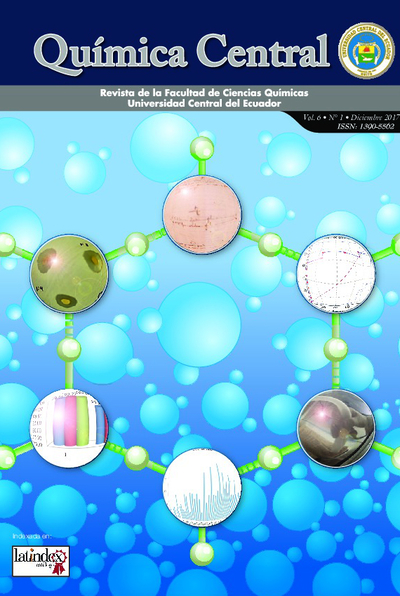Nanoazitromicina preparada por el método solvente/ antisolvente: efecto sobre la disolución
DOI:
https://doi.org/10.29166/quimica.v6i1.1412Keywords:
nanosuspension, azithromycin, solvent / antisolventAbstract
Azithromycin belongs to group II of the biopharmaceutical classification system, its low aqueous solubility explains its
poor bioavailability. The purpose of the present work was to develop a Nano suspension of azithromycin by the solvent
/ antisolvent method to improve its dissolution speed, for this, the influence of the temperature of the dispersion means
was determined. An ethanolic solution of azithromycin (200 mg / ml) was added at a rate of 100 ul / s, on an aqueous
solution of tween 80 (4.5 mg / ml) at 0, 25 and 80°C. Azithromycin nanoparticles of 268.2 nm were obtained, with a
polydispersity index of 0.396, Z potential of -39.6 mV and 94.2% purity. With them, powder was made to reconstitute
oral suspension using hydroxyethyl cellulose as a protective colloid and xanthan gum as a viscosifier. The dissolution
speed of azithromycin nanoparticles is almost 400% higher than azithromycin powder.
Downloads
References
Aulton, M. E. (2004). La ciencia del diseño de las formas farmacéuticas. Madrid: Elsevier.
Lim Chin, W. W., & Parmentier, J. (2014). A Brief Literature and Patent Review of Nanosuspensions to a Final Drug Product. Journal of Pharmaceutical Sciences, 2980-2999.
Brito, Y. (2015). Clasificación Biofarmacéutica Provisional de los Ingredientes Farmacéuticos Activos de los Sólidos Orales de Liberación Inmediata del Cuadro Básico de Medicamentos de Cuba. Santa Clara: Ediciones Alarcos.
Aceituno, A. (23 de 01 de 2013). Decretos 864 y 981: productos afectos, plazos y requerimientos. Obtenido de Departamento Agencia Nacional de Medicamentos Chile: http://www.ispch.cl/sites/default/files/Decretos%20864%20y%20981%20(AAA).pdf
Zhang, Y. (2009). Aspects of Degradation Kinetics of Azithromycin in Aqueous Solution. Chromatographi, 67-63.
AEMPS. (01 de 2011). Agencia Española de Medicamentos y Productos Sanitarios. Obtenido de Gobierno de España: https://www.aemps.gob.es/cima/pdfs/es/ft/61272/FT_61272.pdf
Patel VR, A. Y. (2011). Nanosuspension: An approach to enhanche solubility of drugs. Journal of Advanced Pharmaceutical Technology & Research, 81-87.
Sheth P, S. H. (2012). Nanoparticles in the pharmaceutical industry and the use of supercritical fluid technologies for nanoparticle production. PublMed, 269-284.
Shah, D., & Murdande, S. (2015). A Review: Pharmaceutical and Pharmacokinetic Aspect of Nanocrystalline Suspensions. ELSEVIER, 10-24.
Downloads
Published
How to Cite
Issue
Section
License
Los originales publicados en las ediciones impresa y electrónica de esta revista QUÍMICA CENTRAL son propiedad de la Universidad Central del Ecuador, siendo necesario citar la procedencia en cualquier reproducción parcial o total.
La propiedad intelectual de los artículos publicados en revista QUÍMICA CENTRAL pertenece al/la/los/las autor/a/es/as, y los derechos de explotación y difusión científica están direccionados para la revista QUÍMICA CENTRAL mediante CARTA DE AUTORIZACIÓN DE PUBLICACIÓN publicada en esta plataforma.


